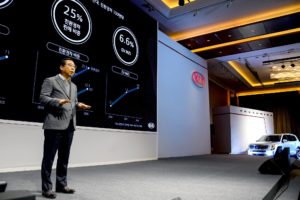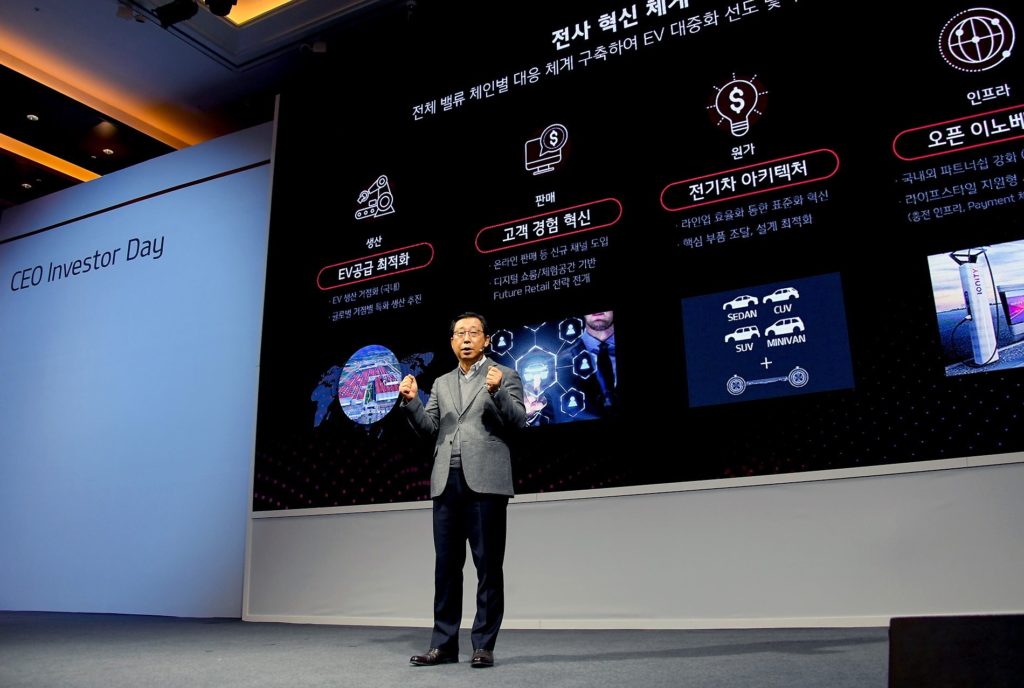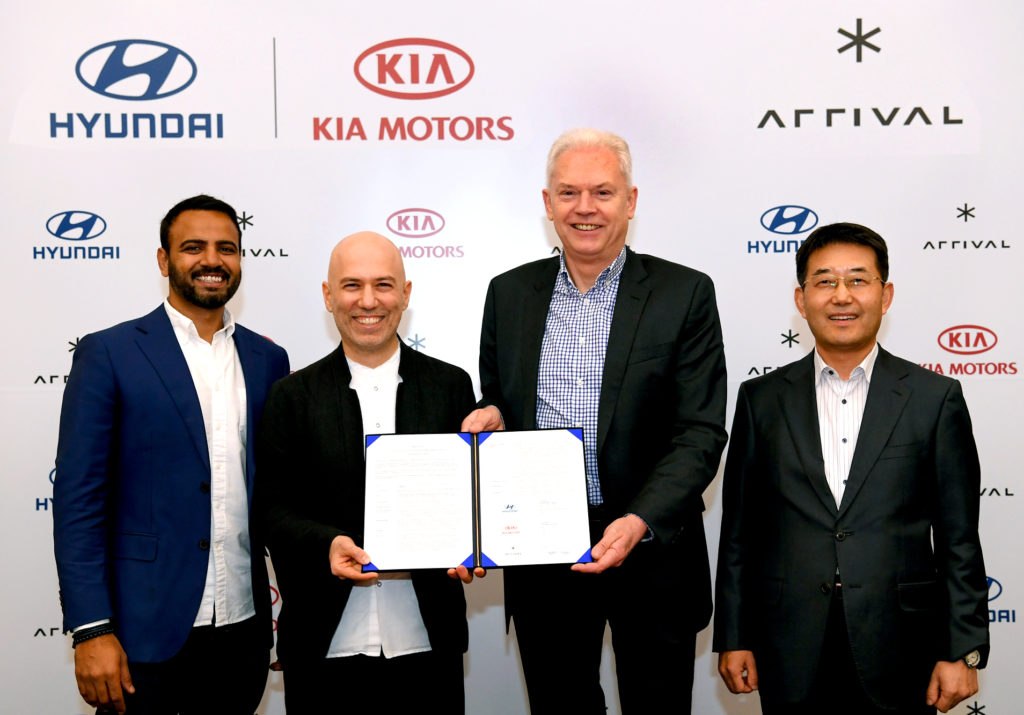
Kia plans 11 electric vehicles by 2025, will launch dedicated EV in ’21
By onAnnouncements | Business Practices | International | Market Trends | Technology
Kia announced last week it would sell 11 battery-electric vehicles globally by 2025 as part of a sweeping “Plan S” that will see it spend $25 billion on electrification and business diversification through that year.
The latter will include creating “Purpose Built” models aimed at corporate buyers and targeting segments like car-sharing and e-commerce.
Kia said it’d find most of that $25 billion by cutting spending on internal combustion engines.
The news indicates that repairers should prepare for an influx of electric vehicles and more diverse fleet vehicles in the near-term.
The former might require investments in special training, equipment, and storage space, as the Society of Collision Repair Specialists warned in a 2019 video.
“Plan S is a bold and enterprising roadmap for Kia’s future business transition, buttressed by the two pillars of electric vehicles and mobility solutions,” Kia CEO Han-woo Park said in a statement. “Our approach is to put customers first, and Kia will reinvigorate its brand innovation by developing products and services that offer new experiences for customers.”
Electric vehicles
Kia wants to sell 500,000 purely electric vehicles outside of China in 2026. Though the U.S. has been seen as lagging other developed countries in demand, that could change as electric charging networks grow and electric vehicle prices fall.
The OEM seems bullish about the demand here.
“In Korea, North American, Europe, and other developed markets which face stricter fuel-efficiency standards, the company will foster the development of the EV industry,” Kia wrote. “A full EV line-up will be established in these markets by 2025, and the sales of EVs will account for about 20% of Kia’s total sales in developed markets.”
Kia said its electric portfolio would include both 800-volt and 400-volt models, which would allow it to serve customers with both “high-performance dedicated models and derivative models with reasonable pricing.”
The company’s first dedicated model will appear in 2021.
“The dedicated EV model to be launched 2021 will be built on a unique platform specifically engineered to accommodate the car’s world-leading EV powertrain and technologies,” Kia wrote. “It will offer a crossover design which blurs the boundaries between passenger and sport utility vehicles, a future-oriented user experience, a single-charge driving range of over 500 kilometers (310.7 miles), and sub-20-minute high-speed charging time.”
MINI recently described to us how various spaces in a gas-powered Cooper S’ body could be emptied and converted to accomodate an electric powertrain without significant changes to the overall vehicle. If Kia opts for a similar approach on its derivative models, repairers might at least catch a break in the form of familiarity.
Kia also assured investors it thought it could build electric vehicles as profitably as gas ones by 2025. It wants to reach an operating margin of 6 percent and a return on equity of 10.6 percent by 2025.
“Of particular importance, Kia will further innovate its basic cost structure via the adoption of an EV architecture development system to consolidate its EV leadership,” Kia wrote. “It is centered on the optimization of design, innovation and standardization, leading to reduced material costs, increased sharing of components from ICE vehicles, new technological developments, and introducing new specifications.”
Kia also might be in a position to grow the electric charging infrastructure. Kia is among the OEMs who own a piece of European high-speed charging infrastructure manufacturer IONITY, and the automaker described plans for a business of electric charging in “other major countries” outside of Europe.
The day after Kia’s announcement, its sister company Hyundai announced both OEMs would invest $110 million into electric startup Arrival. Hyundai is contributing $88 million, and Kia is kicking in $22 million.
Purpose-built vehicles
Kia predicted a big demand shift in the broader commercial fleet through 2030.
“Demand from corporate customers in transport, logistics and distribution businesses is expected to grow significantly over the next decade,” the OEM wrote. “Currently accounting for just 5% of the global auto demand, the customers are projected to grow to 25% by 2030 as e-commerce and ride-sharing services expand.”
Repairers might wish to take a note from Kia and try to get a foot in the door of such fleet customers. But be prepared for more variety.
“The company will go through a transition period of operating a separate trim for existing vehicles such as the Niro EV and Soul EV,” Kia wrote. “It will then develop and supply target client oriented (purpose-built vehicles), such as car-sharing vehicles, low-floor logistics vehicles for onboarding and offboarding, and even delivery trucks equipped with cooling and refrigeration equipment for fresh deliveries. …
“For those PBVs used for special purposes, securing cost competitiveness is of paramount concern. Therefore Kia will actively collaborate with outside players and utilize its own network for the special equipment vehicle business, as well as establish a dedicated development team and production system.”
Kia plans to develop its own “skateboard” electric vehicle platform it can adapt into uses like “mini-size driverless delivery cars and robotaxis.”
Hyundai on Jan. 15 indicated the Arrival-Hyundai-Kia partnership would give Hyundai and Kia access to a scalable electric platform the OEMs could use for purpose-built commercial vehicles.
And speaking of self-driving cars, Kia will work with Aptiv to “develop a leading-edge autonomous driving platform by 2022, and run experimental operations in select areas in 2023.” It predicted commercial production in the second half of 2024.”
More information:
“Kia Motors announces ‘Plan S’ strategy to spearhead transition to EV, mobility solutions by 2025”
Kia, Jan. 14, 2020
“Hyundai and Kia Make Strategic Investment in Arrival to Co-develop Electric Commercial Vehicles”
Hyundai, Jan. 15, 2020
Images:
Kia CEO Han-woo Park discussed “Plan S” on Jan. 14, 2020. (Provided by Kia)
From right, Hyundai commercial vehicle business division head Edward Lee and R&D head Albert Biermann pose with Arrival CEO Denis Sverdlov and Chief Strategy Officer Avinash Rugoobur. (Provided by Hyundai)


